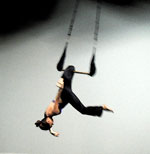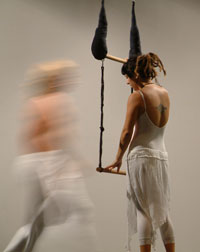
Tucson Choreographer Annie Bunker Does Her
Part For Peace In Northern Ireland.
By Margaret Regan
WHEN ANNIE BUNKER walked to work in Northern Ireland this
summer, her daily route yielded some unusual sights. Up the street
from her house was a fortified police station, barricaded behind
fences and bulletproof glass. A security camera kept an eye on all
passersby. Troops regularly swept streets and fields for bombs, or
charged down the roads in armed vehicles, sirens blaring. Soldiers
armed with automatic weapons patrolled ordinary neighborhoods; and
one evening, when a lonely young soldier fell into step beside
Bunker, his machine gun was between them, hanging casually from his
shoulder.
"It was unnerving, having a machine gun right there,"
said Bunker, a dancer, choreographer and artistic director of
Tucson's O-T-O Dance.
 The look of a country under military occupation may have been
disquieting to Bunker, but it's common to the townsfolk of
Dungannon. It was here, in the heart contested Northern Ireland,
patrolled by British troops for 29 years, that Bunker had accepted a
residency to teach dance to the disabled--to elderly blind ladies,
to developmentally disabled young adults, to stroke the patients.
Why?
The look of a country under military occupation may have been
disquieting to Bunker, but it's common to the townsfolk of
Dungannon. It was here, in the heart contested Northern Ireland,
patrolled by British troops for 29 years, that Bunker had accepted a
residency to teach dance to the disabled--to elderly blind ladies,
to developmentally disabled young adults, to stroke the patients.
Why?
"My ancestry is Scottish and Northern Irish," Bunker
said calmly in her warehouse district studio last week. "I've
always wanted to go there...And my family is interested in the
prehistoric ruins there...It's old, old, old. And (because of) my
love of working with people in different populations."
For five years, Bunker has taught dance to Tucson's Third Street
Kids, a performing troupe of youngsters of assorted abilities and
disabilities. And she has long taught the disabled through her
classroom work sponsored by the Arizona Commission on the Arts. Her
voice grows passionate--and a little impatient--when she talks of
typical attitudes toward disability.
"We don't focus on disability. We focus on what is there. If
you focus on disability you further isolate the person, and the
emphasis is no longer on creating and doing...I do not approach
(dance) as therapy. I approach it as art."
So when Bunker won the Americans for the Arts residency in
Ireland, one of just four American artists to be accepted into the
Irish exchange program, she didn't hesitate. It helped that in May
voters had approved the new peace accord, which guarantees the
Catholics of Northern Ireland a voice in their own government, in
exchange for the Republic dropping its historic political claims on
Ulster.
"It was the eye of the hurricane," Bunker said.
"We were there right in this pocket, following the Good Friday
peace agreement and the election in May (that ratified the peace
treaty) and before the marching season."
And, indeed, deadly trouble erupted the next month, with
Dungannon at the geographic center of the atrocities. Twenty minutes
to the east is Portadown, where three young Catholic brothers were
burned to death in their home in July. Forty miles west lies Omagh,
the market town where, on August 15, a bomb killed 28 shoppers,
mostly women and children, both Protestant and Catholic, and wounded
over 300. President Clinton is to arrive in Ireland on September 3,
and will travel to Omagh for conciliatory meetings in hopes of
saving the U.S.-brokered peace treaty.
Dungannon may have been calm in June, but on the streets
"you could feel it, a tension," Bunker said. One Friday
afternoon, for instance, she was strolling along the lanes. The
crowds were out in force, for their weekend shopping, she supposed,
until she turned and saw Gerry Adams, head of Sinn Fein, political
branch of the Irish Republican Army. It wasn't surprising that Adams
would be out pumping the flesh, campaigning to win doubters over to
the new peace accords. But when Bunker got home and told her
landlady about the celebrity sighting, the woman's face turned red
with anger. She had once come dangerously close to being blown up by
a bomb. Ironically both a Catholic and a stout Unionist, she wants
Northern Ireland to remain part of Britain.
Surprised by the woman's tightly controlled rage, by the clash
between past and future, Bunker thought, "I'm witnessing
history."
Bunker's husband, Chuck Koesters, and their two boys joined her
for the last part of the residency. And while the family saw ruins
of 20th-century vintage--bombed houses without roofs in
Dungannon--they also explored the ancient sites of Northern Ireland
and Scotland, the tombs and cairns and stone circles of prehistory,
and the ruined castles and abbeys of the middle ages.
Koesters was inspired to make videos of the stone circles for a
forthcoming performance piece, and Bunker, entranced by the windows
and doors of castles, said "There are several pieces I want to
do...I'm thinking of three women and a dagger and a spiral
staircase." Since the trip, she and UA dance prof Melissa Lowe
have already completed a Scottish-inspired duet, to be premiered at
the O-T-O October concert.
Koesters said he was struck by the fact that the architectural
evidence of English brutality is all around: old abbeys leveled by
Oliver Cromwell on his punitive sweep across Ireland centuries ago,
the castles of Englishman "planted" in Ireland--on stolen
lands--to dilute Irish resistance to English rule.
"There were horrible atrocities that the Protestants laid on
the Catholics," he said. "The county (Tyrone) is covered
in blood. I have a lot of sympathy for those who wanted a united
Ireland...Part of it is ancient history, part of it is a
(contemporary) social problem." But, he adds, he believes that
ordinary people long to lay the problems to rest.
"I thought I'd run into more opinionated people...It's like
the bombings in Africa, there are little radical pockets. Most
people just want to have a life, raise their families without
conflicts...Women are sick of having their children killed. The zeal
is not as strong as the desire to get this done with."
Can the arts--or a disability dance program--do anything about
it?
Bunker said there's a movement afoot to alter the character of
the parades, so essential a part of traditional Protestant Ulster
culture. Staged every July, the parades celebrate the decisive
defeat of Catholic Ireland in 1690.
"In Belfast, they do a lot of parades that are nonpartisan.
These art parades counteract the political parades. They are finding
ways to offset the focus on traditional parades."
And in the dance studios of Northern Ireland, where Bunker had
the blind women cheerfully shaking out parachute cloth and telling
tales of their young womanhood, and paralyzed stroke patients
gyrating in their chairs, and Down's Syndrome adults making the
whole room into a human sculpture, no one knew whether someone was
Protestant or Catholic.
"In our classes," said Koesters, "it never even
was discussed."
O-T-O Dance celebrates the renovation of its new
warehouse studio, 121 E. Seventh St., with events running September
18 through 20. There's an open house from 10 a.m. to 5:30 p.m.
Friday, September 18, with a concert at 8 p.m. called Space
Between Us, featuring music by Arthur Miscione,
choreography by Beth Braun and performances by the O-T-O dancers and
children. Concert is $6 for adults, $2 for children under 12.
From 10 a.m. to 4 p.m. Saturday, September 19, visitors can watch
classes and rehearsals. Saturday at 7:30 p.m., a poetry reading
called Speaking Spaces Musical Wall features
more than 10 local poets, including Charles Alexander, Alison
Deming, Steve Orlen and Richard Tavenner. Chuck Koesters will play
live music. A donation is asked.
On Sunday, September 20, O-T-O celebrates its 15th birthday with a
party from 5:30 to 8:30 p.m. Performers include dancer Thom Lewis
and harpist Mary Bouley. A $12 ticket gets you food and wine;
$6 for food only. A weekend-long silent auction ends Sunday evening,
when prizes will be awarded.
For more information on this weekend's events and upcoming
concerts, call 624-3799.
Top of Page
|


